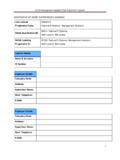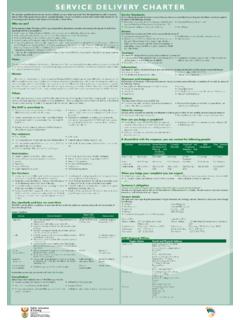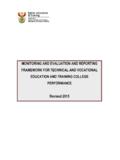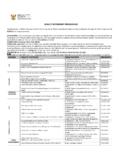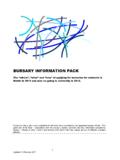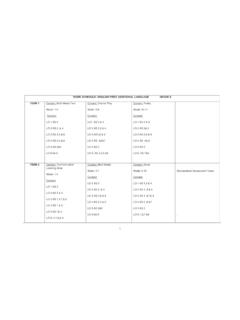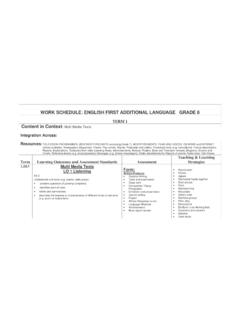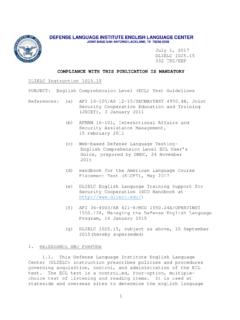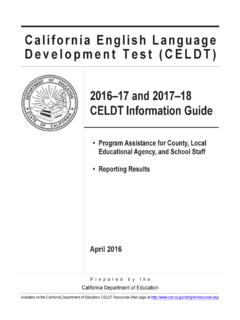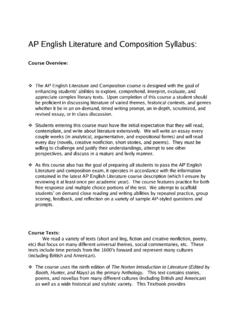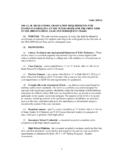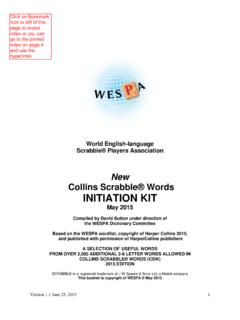Transcription of NATIONAL CERTIFICATES (VOCATIONAL) ASSESSMENT …
1 NATIONAL CERTIFICATES ( vocational ) ASSESSMENT guidelines english first additional language Level 3 Implementation: January 2014 english FAL (Level 3) ASSESSMENT guidelines (January 2014) NATIONAL CERTIFICATES vocational Department of Higher Education and Training Page 2 of 24 Version 17-03-2014 CONTENTS SECTION A: PURPOSE OF THE SUBJECT ASSESSMENT guidelines ------------------------------- 3 SECTION B: ASSESSMENT IN THE NATIONAL CERTIFICATES ( vocational ) -------------------- 3 1. ASSESSMENT PRINCIPLES AND OBJECTIVES ---------------------------------------- ----------------- 3 2. ASSESSMENT FRAMEWORK ---------------------------------------- ---------------------------------------- -- 5 Internal continuous ASSESSMENT (ICASS) ---------------------------------------- -------------------------- 5 External summative ASSESSMENT (ESASS) ---------------------------------------- ------------------------ 5 3.
2 MODERATION OF ASSESSMENT ------------------------------ ---------------------------------------- ------- 5 Internal moderation ---------------------------------------- ---------------------------------------- -------------- 5 External moderation ---------------------------------------- ---------------------------------------- ------------- 5 4. PERIOD OF VALIDITY OF INTERNAL CONTINUOUS ASSESSMENT (ICASS) ------------------ 5 5. ASSESSOR REQUIREMENTS ---------------------------------------- ---------------------------------------- -- 6 6. TYPES OF ASSESSMENT ---------------------------------------- ---------------------------------------- ------- 6 Baseline ASSESSMENT ---------------------------------------- ---------------------------------------- ------------ 6 Diagnostic ASSESSMENT ---------------------------------------- ---------------------------------------- --------- 6 Formative ASSESSMENT ---------------------------------------- ---------------------------------------- ---------- 6 Summative ASSESSMENT ---------------------------------------- ---------------------------------------- -------- 6 7.
3 PLANNING ASSESSMENT ---------------------------------------- ---------------------------------------- ------ 6 Collecting evidence ---------------------------------------- ---------------------------------------- -------------- 6 Recording ---------------------------------------- ---------------------------------------- -------------------------- 6 Reporting ---------------------------------------- ---------------------------------------- --------------------------- 6 8. METHODS OF ASSESSMENT ---------------------------------------- ---------------------------------------- -- 6 9. INSTRUMENTS AND TOOLS FOR COLLECTING EVIDENCE ---------------------------------------- 7 10.
4 TOOLS FOR ASSESSING STUDENT PERFORMANCE ---------------------------------------- --------- 8 11. SELECTING AND/OR DESIGNING RECORDING AND REPORTING SYSTEMS----------------- 8 12. COMPETENCE DESCRIPTIONS ---------------------------------------- --------------------------------------- 8 13. STRATEGIES FOR COLLECTING EVIDENCE ---------------------------------------- --------------------- 8 Record sheets ---------------------------------------- ---------------------------------------- ----------------- 8 Checklists ---------------------------------------- ---------------------------------------- ----------------------- 8 SECTION C: ASSESSMENT IN english FAL ---------------------------------------- -------------------------- 10 1.
5 ASSESSMENT SCHEDULE AND REQUIREMENTS---------------------------- ------------------------- 10 2. RECORDING AND REPORTING ---------------------------------------- -------------------------------------- 12 3. INTERNAL ASSESSMENT OF OUTCOMES IN english FAL - LEVEL 3 ------------------------ 13 4. EXTERNAL ASSESSMENT IN english FAL - LEVEL 3 ---------------------------------------- ------ 19 ANNEXURE A: EXAMPLES OF TEMPLATES ---------------------------------------- --------------------------- 23 english FAL (Level 3) ASSESSMENT guidelines (January 2014) NATIONAL CERTIFICATES vocational Department of Higher Education and Training Page 3 of 24 Version 17-03-2014 SECTION A: PURPOSE OF THE SUBJECT ASSESSMENT guidelines This document provides the lecturer with guidelines to develop and implement a coherent, integrated ASSESSMENT system for english FAL in the NATIONAL CERTIFICATES ( vocational ).
6 It must be read with the NATIONAL Policy Regarding Further Education and Training Programmes: Approval of the Documents, Policy for the NATIONAL CERTIFICATES ( vocational ) Qualifications at Levels 2 to 4 on the NATIONAL Qualifications Framework (NQF). This document explains the requirements for the internal and external subject ASSESSMENT . The lecturer must use this document with the Subject guidelines : english FAL Level 3 to prepare for and deliver the subject. Lecturers should use a variety of resources and apply a range of ASSESSMENT skills in the setting, marking and recording of ASSESSMENT tasks.
7 SECTION B: ASSESSMENT IN THE NATIONAL CERTIFICATES ( vocational ) 1. ASSESSMENT PRINCIPLES AND OBJECTIVES ASSESSMENT in the NATIONAL CERTIFICATES ( vocational ) is underpinned by the objectives of the NATIONAL Qualifications Framework (NQF). These objectives are to: Create an integrated NATIONAL framework for learning achievements. Facilitate access to and progression within education, training and career paths. Enhance the quality of education and training. Redress unfair discrimination and past imbalances and thereby accelerate employment opportunities. Contribute to the holistic development of the student by addressing: social adjustment and responsibility; moral accountability and ethical work orientation; economic participation; and nation-building.
8 The principles that drive these objectives are: Integration To adopt a unified approach to education and training that will strengthen the human resources and develop the capacity of the nation. Relevance To be dynamic and responsive to NATIONAL development needs. Credibility To demonstrate recognition of competencies and skills acquired, NATIONAL and international added value and recognition of the acquired qualification Coherence To work within a consistent framework of principles and certification. Flexibility To allow for creativity and resourcefulness when achieving Learning Outcomes, to cater for different learning styles and use a range of ASSESSMENT methods, instruments and techniques.
9 Participation To enable stakeholders to participate in the setting of standards and the co-ordination of the achievements required for the qualification. english FAL (Level 3) ASSESSMENT guidelines (January 2014) NATIONAL CERTIFICATES vocational Department of Higher Education and Training Page 4 of 24 Version 17-03-2014 Access To address barriers to learning experienced on different levels and to facilitate the students progress. Progression To ensure the qualification framework permits individuals to move through the levels of the NATIONAL qualification via different, appropriate combinations of the components of the delivery system.
10 Portability To enable students to transfer credits obtained within a qualification from one learning institution and/or employer to another institution or employer. Articulation To allow for vertical and horizontal mobility in the educational system on condition that accredited pre-requisites have been successfully completed. Recognition of Prior Learning To grant credits for a unit of learning following an ASSESSMENT process or where a student possesses the capabilities as specified in the outcomes. Validity of assessments To ensure ASSESSMENT covers a broad range of skills, knowledge, values and attitudes (SKVAs) needed to demonstrate applied competency.
